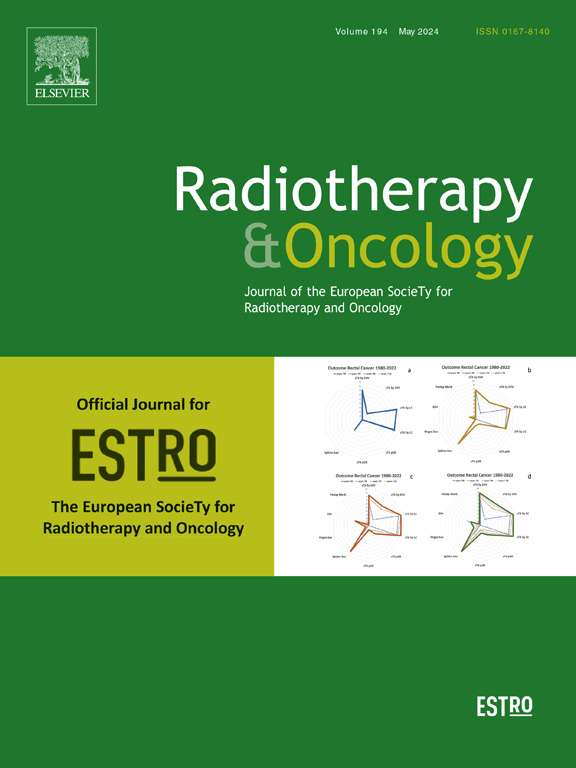精原细胞瘤患者接受当前和以往放疗方案治疗的第二原发癌风险:系统文献综述。
IF 4.9
1区 医学
Q1 ONCOLOGY
引用次数: 0
摘要
背景和目的:精原细胞瘤患者术后放射治疗(RT)大动脉旁野(PAO) +/-髂旁野(狗腿)是一种有效的治疗方法,但与膈下辐射诱发的第二原发癌(SPC)的终生风险相关。我们进行了一项系统综述,以调查危及器官的剂量(OAR)、相关的SPC风险和rt方案的里程碑式变化,并对质子治疗特别感兴趣。方法:采用PRISMA指南进行系统文献检索(1990-2024)。结果:我们确定了11项队列研究,报告了RT后胰腺、肾脏、胃、(狗腿部位)膀胱和结直肠的SPC风险持续增加。在过去的60 年中,重要的RT标志是:放弃纵隔和腹股沟RT,仅在I期进行PAO,处方剂量从30-40 Gy减少到20-26 Gy,在很大程度上放弃选择性PAO治疗I期精原细胞瘤,支持主动监测,以及引入质子治疗。在II期(狗腿强化)和高风险的I期精原细胞瘤中,RT仍然是一种选择。两项研究估计了胰腺和胃的剂量-反应关系。五项计划研究显示质子与光子治疗的OAR剂量降低一致。与常规放射治疗相比,调强放射治疗的OAR剂量相似或更高,这是由于更大的低剂量放射治疗。结论:既定的SPC风险已经改变了精原细胞瘤患者的临床实践,并且仍然与当前的RT实践相关。质子治疗有可能减少有SPCs危险的相关桨叶的剂量。需要进一步研究分离RT和质子对SPC的剂量-反应关系,以改进SPC的风险评估。本文章由计算机程序翻译,如有差异,请以英文原文为准。
Second primary cancer risks in seminoma patients treated with current and previous radiotherapy protocols: a systematic literature review
Background and purpose
Postoperative radiotherapy (RT) with para-aortal (PAO) +/- para-iliac (dog-leg) fields in seminoma patients is an effective treatment, associated with a lifetime risk of developing infra-diaphragmatic radiation-induced second primary cancers (SPC). We performed a systematic review to investigate dose to organs at risk (OAR), associated SPC risks, and landmark changes in RT-protocols, with a special interest in proton therapy.
Methods
A systematic literature search (1990–2024) was conducted using PRISMA guidelines.
Results
We identified eleven cohort studies reporting consistently excess SPC risks for pancreas, kidney, stomach, and (for dog-leg field) bladder, and colorectum after RT. Important RT-landmarks during the past 60 years were: abandoning mediastinal and inguinal RT, PAO only in stage I, prescription-dose reductions from 30-40 Gy to 20–26 Gy, largely abandoning elective PAO for stage I seminoma in favour of active surveillance, and introduction of proton therapy. RT remains an option in stage II (dog-leg with boosting) and high-risk stage I seminoma. Two studies estimated the dose–response-relationship for pancreas and stomach. Five planning studies showed consistent OAR dose reductions with proton versus photon therapy. Similar or higher OAR doses were observed with intensity-modulated versus conventional RT, due to larger low-dose baths.
Conclusions
Established SPC risks have changed clinical practice in seminoma patients, and remain relevant for current RT practice. Proton therapy has the potential to reduce dose in relevant OARs at risk for SPCs. Further research on dose–response relationships for SPCs with fractionated RT and protons is needed to improve SPC risk assessment.
求助全文
通过发布文献求助,成功后即可免费获取论文全文。
去求助
来源期刊

Radiotherapy and Oncology
医学-核医学
CiteScore
10.30
自引率
10.50%
发文量
2445
审稿时长
45 days
期刊介绍:
Radiotherapy and Oncology publishes papers describing original research as well as review articles. It covers areas of interest relating to radiation oncology. This includes: clinical radiotherapy, combined modality treatment, translational studies, epidemiological outcomes, imaging, dosimetry, and radiation therapy planning, experimental work in radiobiology, chemobiology, hyperthermia and tumour biology, as well as data science in radiation oncology and physics aspects relevant to oncology.Papers on more general aspects of interest to the radiation oncologist including chemotherapy, surgery and immunology are also published.
 求助内容:
求助内容: 应助结果提醒方式:
应助结果提醒方式:


